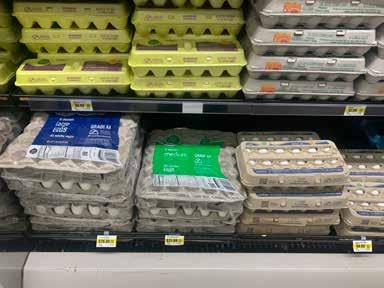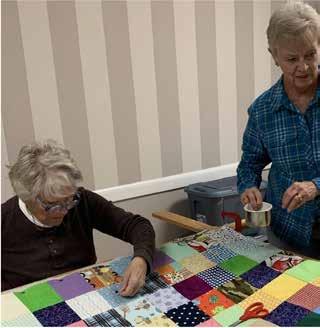
6 minute read
Egg Prices
By Allison Eliason
It used to be that eggs were a relatively cheap and healthy way to add some protein into your diet. It was the inexpensive breakfast go-to in all its varieties- scrambled, fried, poached or as omelets. Eggs were always in abundance and never were the deciding ingredient for any recipe. But the way this topsy-turvy world has turned, even the idea of cheap eggs has become backwards thinking. Consumer Price Index showed a 59.9% increase in egg prices just last month, averaging at $4.25 across the country.
The post pandemic world of supply chain issues and labor shortages have played its part in price hikes and overall inflation of the grocery bill. It's not just luxury items or the superfluous wants that are now spendy at the checkout counter, but refrigerator staples like eggs too.
The rising fuel costs that have had rippling effects in other industries and markets have influenced egg prices as well. Whether it is in the fuel for production or the fuel to transport the eggs to the grocery store, it all adds up to a heftier bill for the customer at the checkout.
Animal producers across all sectors have struggled with increased feed costs due to several factors from the drought still frustrating farmers throughout the country to the conflict between Ukraine and Russia. Chicken farmers aren’t immune to these rising expenses and it shows in the final price of their eggs.
Challenges in any one of these areas- production, transportation and labor- would be enough to cause havoc in the egg market and having all of these issues at once is sure to cause problems. And to make matters worse, the United States is currently in the worst avian flu epidemic it has ever seen.
Over the last year, nearly 58 million birds have been lost, either due to the virus itself or due to the FDAs attempts to stop the spread by destroying infected or exposed flocks. The flu has been found in wild birds, commercial poultry and backyard flocks alike in the more than 700 outbreaks. All fifty states have found it in wild birds and forty-seven have found it in poultry flocks of all sizes. Here in Idaho, eight counties, Ada, Canyon, Caribou, Gem, Gooding, Madison, Twin Falls and Valley, have reported nearly 30 outbreaks, affecting more than 10,000 birds.
The avian flu epidemic has put a crucial crunch in an already declining number of eggs set for retail. Farmers are working to overcome their losses by rebuilding their flocks, but that is a struggle in itself. Fewer hens means fewer eggs laid, whether they are intended to be sent to the grocery store or to be hatched as the next generation of layers.
In Colorado and California, they are facing an even greater problem keeping egg cartons on the shelves with their new animal welfare laws that require eggs to come from cage-free chickens, further limiting their supply
Fortunately, numbers have not become so low as to leave customers without any buying option, but rather demand a steep price. It is possible that we are passed the worst of the shortage, but many in the industry aren’t so sure. While flu numbers have begun to decline, the spring migration is likely to bring a resurgence of the virus as wild birds are the main carrier of the illness. For the time being, egg enthusiasts will have to decide whether they are willing to shell out the big bucks for a dozen or if they will turn up their feathers and balk at the rising prices.
Senior Corner—Quilters Guild
By Jill Vanderood Historian
The Oneida County Quilt Guild met on Thursday, January 12 at the Malad Senior
Center.
This is a new year and a new beginning for the Quilt Guild. We have new officers to start the year. The co-Presidents of the guild are Brenda Daniels and Esther Emerson.
The guild will meet every second Thursday in 2023. Quilters of all levels are welcome to meet with us.
The dues for the year are only $10. And most meetings include a tasty lunch, provided by the luncheon committee, assigned for that month. his year promises to be a great year with quilters working on squares for a new friendship quilt, lessons in paper piecing and expert quilters sharing their work for a trunk show of their many beautiful, quilted masterpieces.
Quilters will be taught new skills and each meeting begins with a show and tell, where we bring in our accomplishments from the month or months before. Quilters can also work on their own projects, learn to do something new or assist in tying a charity quilt.
At the January meeting, Esther helped us to organize:
UFOs - Unfinished Objects
WIPEs - Works In Progress . . . Eventually
PIGS - Projects in Grocery Sacks
PHD - Project Half Done
Welcome to all returning members and we hope for new faces to join us!

Carolee Cox and Nyla Evans are working on a charity quilt The proposed site of the new Elementary school


Upcoming School Bond Basics
Continued from front page severe damage should an earthquake hit Malad Valley. For instance, the walls are not tied to the roof, which could result in the building collapsing in a violent earthquake, similar to the 6.5 earthquake centered 40 miles west of Malad in 1975.
Additionally, the building is not compliant with the Americans with Disabilities Act (ADA) because it is a two-story building with no easy access to the second floor. A lift was used for several years, but it was discontinued because the configuration of the staircases made it difficult to use. If a student or staff member requires special accommodations, classrooms are shuffled so that the person does not have to get to the second floor, which can cause a lot of disruption to the organization and management of the school year.
Technology is also a constant problem in the nearly 70-year-old building, primarily due to the cinder brick walls, which have to be drilled to allow wi-fi access. The walls also affect the efficiency of the Wi-Fi broadcasting within the building itself.
The building has no air conditioning, and heating the building is a huge expense for the District. The single-paned windows throughout the building allow cold air to blow into classrooms. The proposed new school will be built to high-efficiency specifications and should dramatically reduce the utility costs, especially during the winter.
When the building was constructed in the 1950s, concerns for student safety did not include precautions against intruders and active shooters. With multiple exterior doors and the south-facing classrooms all having doors leading to the playground, student safety is a constant concern for teachers and parents. A design with a more focused set of entrance and exit control points would improve safety and security considerably.
The building, which used to be the pride of Malad, is now comparatively run-down and outdated and, in the opinion of many local officials, does not reflect well on the educational opportunities available to students in Oneida School District nor on the efforts of teachers, staff, parents, and students themselves to provide up-to-date curricula and activities through the elementary school.
FOR RENT
2 BD, 1.5 BA House 1Car Garage 2 Car Carport Covered Patio Washer & Dryer Incl. NO SMOKING 1st & Last Month Required Call Kathy 208-251-2253
ONEIDA COUNTY LIBRARY Planning a Disney Vacation?
Additional information
Because the future of the new school and the fate of the bond election are issues that affect the community greatly, future articles in the Idaho Enterprise will address other questions citizens have had about funding of a new Malad Elementary School. In upcoming weeks, we plan to cover the proposed design for the new school, details about the Bond Equalization program that will help defray the expenses of the project, and other issues related to the school project.
Individuals and groups that have questions are urged to contact Superintendent Jon Abrams (208-534-6080 ext.412) to set up one-on-one or small group meetings to discuss the new building and plans for funding. More information is available on the District website: www.oneidaschooldistrict.com.


